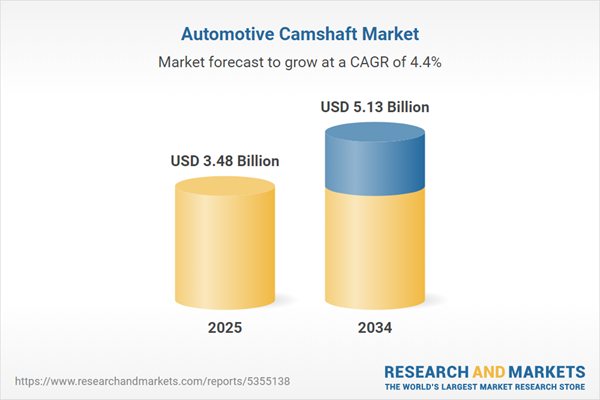Automotive Camshaft Market
Automotive camshafts remain core to valve timing and breathing across gasoline, diesel, and gas-fueled internal combustion engines, while hybrids and range-extenders sustain long production lifecycles despite the growth of battery-electric vehicles. Primary end-uses span passenger cars and light trucks, heavy commercial vehicles, two-wheelers, agriculture/construction equipment, marine, and stationary engines tied to mobility platforms. Recent trends emphasize DOHC architectures with sophisticated cam phasing, variable valve lift mechanisms, and tighter controls over torsional stiffness and oil-aeration effects at high RPM/load. Materials and processes are evolving from traditional chilled-cast iron toward forged steel, assembled and hollow camshafts with press-fitted lobes, and powder-metal components to reduce mass and inertia while maintaining surface hardness. Drivers include stricter emissions and fuel-economy targets, downsized turbo engines requiring high contact fatigue resistance, low-viscosity oils, and extended service intervals. The competitive landscape blends global Tier-1 system specialists with regional foundries and machine shops, supported by semiconductor and actuator suppliers for phasers and lift systems. Differentiation rests on lobe profile accuracy, wear systems (induction hardening, nitriding, DLC), lightweighting without NVH penalties, and turnkey capability from casting/forging through finish grinding and metrology. Supply strategies prioritize localization near engine plants, energy-efficient heat treatment, and rigorous PPAP/change-control. As OEMs rationalize platforms and pursue software-calibrated valve strategies, winning suppliers offer flexible lines, digital quality records, and collaborative engineering to co-optimize profiles, bearings, followers, and timing drives - delivering durability and compliance without sacrificing drivability or cost targets.Automotive Camshaft Market Key Insights
- ICE-hybrid coexistence shapes demand. Battery-electrics displace cams on pure EVs, yet hybrids, two-wheelers, commercial and off-highway fleets extend long-tail volumes. Program continuity favors suppliers with validated designs across multiple engine families and rapid changeover to meet mid-cycle upgrades and localized emissions calibrations.
- Technology mix tilts toward advanced timing. Widespread variable cam phasing and selective variable lift demand higher torsional stiffness, precise phaser interfaces, and tight correlation with cam sensors. Robust oil management and leak-down characteristics enable fast restarts in start-stop and hybrid duty, preserving emissions control and idle quality.
- Material transitions unlock weight and durability. Forged steel and assembled/hollow designs reduce rotating mass and improve bending fatigue margins. Powder-metal lobes and laser-welded joints offer design freedom; process control (brazing, press-fit interference, runout) underwrites longevity under turbocharged peak loads.
- Surface engineering is a performance lever. Induction hardening, nitriding, and DLC coatings mitigate scuffing and micropitting under boundary lubrication with low-viscosity oils. Optimized lobe micro-geometry and finish grinding reduce contact stress and follower wear, protecting catalyst light-off and real-world fuel economy.
- Quality and metrology move in-line and digital. In-process gauging, camcorder measurement, and chatter fingerprinting cut scrap and ensure lobe phasing accuracy. Traceability via laser IDs and e-records streamlines warranty analysis and supports over-time correlation with valve-train NVH and oil-system behavior.
- Aftermarket remains structurally relevant. Replacement demand stems from wear, oil starvation, timing failures, and performance upgrades. Coverage breadth, OE-equivalent calibration, counterfeit mitigation, and installer education reduce no-fault returns; reman and core-return programs add value in cost-sensitive channels.
- Platform consolidation raises bar for flexibility. Fewer, global engine families increase volume per program but require regional variants. Reconfigurable lines, modular fixtures, and quick-change tooling allow suppliers to pivot between cylinder counts, journal sizes, and profile sets without downtime penalties.
- Cost and energy pressures reshape processes. Volatile metal and energy inputs push adoption of near-net forging, optimized heat-treat cycles, and waste-heat recovery in furnaces. Scrap reduction, coolant management, and tool-life analytics support competitiveness while meeting sustainability commitments.
- Risk from cam-less concepts is contained near-term. Electro-hydraulic or electromagnetic valve systems remain niche due to cost, packaging, and reliability hurdles. Incremental advances in phasing and lift offer favorable cost-benefit, keeping mechanical cams dominant across high-volume segments.
- Ecosystem engineering drives outcomes. Co-design with followers, springs, phasers, and lubrication delivers systemic gains in friction, emissions, and durability. Early simulation of thermal warp, torsional modes, and oil aeration, combined with robust DVP&R, de-risks launches and minimizes field variability.
Automotive Camshaft Market Reginal Analysis
North America
Demand concentrates in pickups/SUVs, performance trims, and commercial fleets, supported by a substantial service aftermarket. Programs emphasize torsional stiffness for towing and high-load cycles, rapid phaser authority for emissions, and durability under extended oil intervals. Localization in the US and Mexico favors suppliers with integrated forging, machining, and heat treatment. Aftermarket success hinges on SKU coverage, OE-grade hardness profiles, and installer training to reduce misdiagnosis with timing and oil-system faults.Europe
Tight emissions compliance and high calibration sophistication drive stringent requirements for lobe accuracy, surface integrity, and correlation with VVT and VVL. Lightweight assembled/hollow shafts and premium surface treatments are common on downsized turbo engines. Energy costs and sustainability targets encourage efficient furnaces, recycled feedstock, and closed-loop coolant systems. Proximity to engine plants in Central/Eastern Europe supports logistics, while premium brands demand exemplary PPAP and change-control discipline.Asia-Pacific
Scale spans passenger vehicles, two-wheelers, LCVs, and export engines, with strong localization in China and India and advanced programs in Japan and Korea. Cost-optimized forged and cast solutions dominate volume segments, while high-end platforms adopt assembled/hollow and enhanced coatings. Humidity, dust, and wide temperature ranges shape sealing and corrosion protection. Two-wheeler and small-engine markets prize robust materials and simple serviceability alongside aggressive pricing.Middle East & Africa
Harsh heat, dust, and variable fuel quality prioritize high-temperature stability, ingress protection, and abrasion-resistant surfaces. Commercial vehicles and off-highway equipment form the core base, with long service lives sustaining replacement demand. Import-reliant supply chains value dependable lead times and straightforward installation guidance. As inspection regimes tighten, consistent hardness and traceability improve acceptance and reduce warranty friction.South & Central America
Local engine manufacturing and large used-vehicle parcs generate steady OE and aftermarket needs. Flex-fuel usage and challenging road conditions require robust cam/follower interfaces and reliable lubrication behavior. Distribution depends on strong regional wholesalers and clear fitment documentation. Cost sensitivity favors durable cast solutions, while fleets and premium segments adopt advanced surface treatments and precise phaser interfaces to meet evolving emissions and drivability expectations.Automotive Camshaft Market Segmentation
By Vehicle
- Passenger Vehicle
- Commercial Vehicle
By Fuel
- Gasoline
- Diesel
By Engine
- Inline Engine
- V-engine
- Others
By Sales Channel
- Original Equipment Manufacturer
- Aftermarket
By Manufacturing Technology
- Cast Camshaft
- Forged Camshaft
- Assembled Camshaft
Key Market players
thyssenkrupp Camshafts, MAHLE, Precision Camshafts Ltd (PCL), Seojin Cam, Mitec Automotive, Linamar (Camshaft Machine Company), ESTAS Camshaft, AVL Schrick, Comp Cams, Crane Cams, Crower Cams & Equipment, Cat Cams, Piper Cams, Newman Cams, Melling Engine Parts, Schaeffler (INA) Camshaft Modules, Musashi Seimitsu Industry, Iskenderian (Isky) Racing Cams, Elgin Cams, Howards CamsAutomotive Camshaft Market Analytics
The report employs rigorous tools, including Porter’s Five Forces, value chain mapping, and scenario-based modelling, to assess supply-demand dynamics. Cross-sector influences from parent, derived, and substitute markets are evaluated to identify risks and opportunities. Trade and pricing analytics provide an up-to-date view of international flows, including leading exporters, importers, and regional price trends.Macroeconomic indicators, policy frameworks such as carbon pricing and energy security strategies, and evolving consumer behaviour are considered in forecasting scenarios. Recent deal flows, partnerships, and technology innovations are incorporated to assess their impact on future market performance.
Automotive Camshaft Market Competitive Intelligence
The competitive landscape is mapped through proprietary frameworks, profiling leading companies with details on business models, product portfolios, financial performance, and strategic initiatives. Key developments such as mergers & acquisitions, technology collaborations, investment inflows, and regional expansions are analyzed for their competitive impact. The report also identifies emerging players and innovative startups contributing to market disruption.Regional insights highlight the most promising investment destinations, regulatory landscapes, and evolving partnerships across energy and industrial corridors.
Countries Covered
- North America - Automotive Camshaft market data and outlook to 2034
- United States
- Canada
- Mexico
- Europe - Automotive Camshaft market data and outlook to 2034
- Germany
- United Kingdom
- France
- Italy
- Spain
- BeNeLux
- Russia
- Sweden
- Asia-Pacific - Automotive Camshaft market data and outlook to 2034
- China
- Japan
- India
- South Korea
- Australia
- Indonesia
- Malaysia
- Vietnam
- Middle East and Africa - Automotive Camshaft market data and outlook to 2034
- Saudi Arabia
- South Africa
- Iran
- UAE
- Egypt
- South and Central America - Automotive Camshaft market data and outlook to 2034
- Brazil
- Argentina
- Chile
- Peru
Research Methodology
This study combines primary inputs from industry experts across the Automotive Camshaft value chain with secondary data from associations, government publications, trade databases, and company disclosures. Proprietary modeling techniques, including data triangulation, statistical correlation, and scenario planning, are applied to deliver reliable market sizing and forecasting.Key Questions Addressed
- What is the current and forecast market size of the Automotive Camshaft industry at global, regional, and country levels?
- Which types, applications, and technologies present the highest growth potential?
- How are supply chains adapting to geopolitical and economic shocks?
- What role do policy frameworks, trade flows, and sustainability targets play in shaping demand?
- Who are the leading players, and how are their strategies evolving in the face of global uncertainty?
- Which regional “hotspots” and customer segments will outpace the market, and what go-to-market and partnership models best support entry and expansion?
- Where are the most investable opportunities - across technology roadmaps, sustainability-linked innovation, and M&A - and what is the best segment to invest over the next 3-5 years?
Your Key Takeaways from the Automotive Camshaft Market Report
- Global Automotive Camshaft market size and growth projections (CAGR), 2024-2034
- Impact of Russia-Ukraine, Israel-Palestine, and Hamas conflicts on Automotive Camshaft trade, costs, and supply chains
- Automotive Camshaft market size, share, and outlook across 5 regions and 27 countries, 2023-2034
- Automotive Camshaft market size, CAGR, and market share of key products, applications, and end-user verticals, 2023-2034
- Short- and long-term Automotive Camshaft market trends, drivers, restraints, and opportunities
- Porter’s Five Forces analysis, technological developments, and Automotive Camshaft supply chain analysis
- Automotive Camshaft trade analysis, Automotive Camshaft market price analysis, and Automotive Camshaft supply/demand dynamics
- Profiles of 5 leading companies - overview, key strategies, financials, and products
- Latest Automotive Camshaft market news and developments
Additional Support
With the purchase of this report, you will receive:- An updated PDF report and an MS Excel data workbook containing all market tables and figures for easy analysis.
- 7-day post-sale analyst support for clarifications and in-scope supplementary data, ensuring the deliverable aligns precisely with your requirements.
- Complimentary report update to incorporate the latest available data and the impact of recent market developments.
This product will be delivered within 1-3 business days.
Table of Contents
Companies Mentioned
- thyssenkrupp Camshafts
- MAHLE
- Precision Camshafts Ltd. (PCL)
- Seojin Cam
- Mitec Automotive
- Linamar (Camshaft Machine Company)
- ESTAS Camshaft
- AVL Schrick
- Comp Cams
- Crane Cams
- Crower Cams & Equipment
- Cat Cams
- Piper Cams
- Newman Cams
- Melling Engine Parts
- Schaeffler (INA) Camshaft Modules
- Musashi Seimitsu Industry
- Iskenderian (Isky) Racing Cams
- Elgin Cams
- Howards Cams
Table Information
| Report Attribute | Details |
|---|---|
| No. of Pages | 160 |
| Published | November 2025 |
| Forecast Period | 2025 - 2034 |
| Estimated Market Value ( USD | $ 3.48 Billion |
| Forecasted Market Value ( USD | $ 5.13 Billion |
| Compound Annual Growth Rate | 4.4% |
| Regions Covered | Global |
| No. of Companies Mentioned | 20 |









